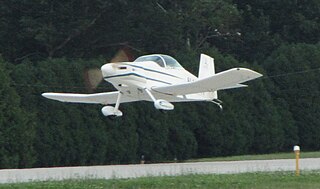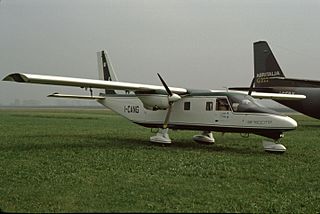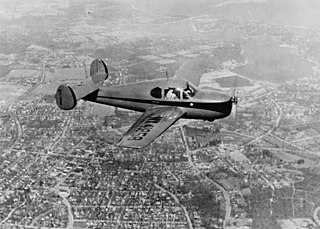Related Research Articles

The Piper PA-28 Cherokee is a family of two-seat or four-seat light aircraft built by Piper Aircraft and designed for flight training, air taxi and personal use. The PA-28 family of aircraft comprises all-metal, unpressurized, single piston-engined airplanes with low-mounted wings and tricycle landing gear. They have a single door on the right side, which is entered by stepping on the wing.

The Helio Courier is a cantilever high-wing light STOL utility aircraft designed in 1949.

The Thorp T-18 is an American, two-place, all-metal, plans-built, homebuilt aircraft designed in 1963 by John Thorp.

The Partenavia P.68, now Vulcanair P68, is a light aircraft designed by Luigi Pascale and initially built by Italian Partenavia. It made its first flight on 25 May 1970, its type certification was granted on 17 November 1971 and was transferred to Vulcanair in 1998. The original six-seat high-wing monoplane is powered by twin piston engines and is used for light transport and training. The P.68 Observer is an observation aircraft variant, and it was developed in a stretched, 10/11-seat twin turboprop derivative.

The Cessna 421 Golden Eagle is an American six or seven seat twin-engined light transport aircraft, developed in the 1960s by Cessna as a pressurized version of the earlier Cessna 411.
The Titan T-51 Mustang is a three-quarter scale replica of the P-51 Mustang that was designed by Titan Aircraft owner John Williams. It is a two-seat homebuilt aircraft with dual controls and tandem seats, and has remarkable performance given the small size of the engine.

The Tecnam P92 Echo and Tecnam P92 Eaglet are Italian high-winged, light aircraft, designed by Luigi Pascale and built by Tecnam of Naples.

The Vulcanair SF.600 Canguro was a feederliner developed in Italy in the late 1970s. Despite a number of attempts to put the aircraft into series production, only a small number were ever built. The Canguro was a high-wing cantilever monoplane of conventional configuration with a fuselage of rectangular cross-section and a high-set tail. The tricycle undercarriage was not retractable, and its main units were carried on sponsons on the fuselage sides. SIAI Marchetti provided funding towards the construction of the prototype, and constructed this aircraft at the former Aviamilano plant. After flight testing proved positive, the type was put on sale, but failed to attract buyers in any number, even when the original piston engines were exchanged for turboprops and retractable undercarriage was offered as an option.

The Jeffair Barracuda is a high-performance sporting monoplane that was developed in the United States in the 1970s and is marketed for homebuilding. Designed and built by Geoffrey Siers, the prototype won the prize for "Most Outstanding New Design" at the EAA Fly-in in 1976. It was a low-wing cantilever monoplane of wooden construction with retractable tricycle undercarriage and side-by-side seating for two. Around 150 sets of plans had sold by 1977.

The Wassmer WA-51 Pacific is a French four-seat cabin monoplane designed and built by Société Wassmer. Different-powered variants include the Wassmer WA-52 Europa and the Wassmer WA-54 Atlantic. It was the world's first composite material-built aircraft.

The Grumman Kitten was a 1940s American cabin monoplane designed and built by Grumman. Two versions were built; the G-63 Kitten I with a retractable tailwheel landing gear, and G-72 Kitten II with a retractable nosewheel landing gear.

The Jurca MJ-5 Sirocco is a two-seat sport aircraft designed in France in the early 1960s and marketed for homebuilding. It is one of many wooden homebuilt designs from Romanian born designer Marcel Jurca. Jurca, a Henschel Hs 129 pilot in World War II marketed the plans in Canada and America through Falconar Aviation. It is a low-wing cantilever monoplane of conventional configuration and wooden construction throughout. The tandem seats are enclosed by a bubble canopy, and the tailwheel undercarriage can be built as either fixed or with retractable main units. Marcel Jurca died on 19 October 2001, at which time plans were still available from the designer's website.

The Swearingen SX-300 is a high-performance homebuilt aircraft, featuring two seats and developed by Ed Swearingen during the 1980s.
The Mooney 301 was a prototype aircraft created by American manufacturer Mooney Aircraft Company in 1983. It was a low-wing, single-engine, six-place monoplane with retractable landing gear and a pressurized fuselage.
The Jurca MJ-53 Autan is a plans-built, low-wing, touring monoplane designed in France by Marcel Jurca.
The Mini Mustang was a scale replica of the P-51 Mustang. It featured aluminium construction and manual retractable landing gear.

The Polen Special, is a homebuilt racing aircraft built to become the fastest four cylinder aircraft in the world.
The Falconar SAL Mustang, also called the 2/3 Mustang and the SAL P-51D Mustang is a Canadian amateur-built aircraft, originally produced by Falconar Avia and introduced in 1969. The aircraft is a 2⁄3 scale replica of the North American P-51 Mustang and is supplied as a kit or as plans for amateur construction.
The Stewart S-51D Mustang is an American aerobatic homebuilt aircraft that was designed by Jim Stewart and produced by Stewart 51 of Vero Beach, Florida, introduced in 1994. When it was available the aircraft was supplied as a kit for amateur construction.

The Stinson Model R was an American light aircraft built by the Stinson Aircraft Company in the early 1930s. It was a single-engine high-winged monoplane, developed from the Stinson Junior. 39 units were built.
References
Notes
- 1 2 3 4 5 6 7 Jackson 2004, pp. 623-624
- 1 2 3 4 5 "Hotline". Sport Aviation. January 1998. pp. 10–11.
- ↑ "Team 51 History" . Retrieved October 14, 2019.
- ↑ Levy, Howard (September 1999). "Murdo Cameron puts a new spin on a classic design". Kit Planes.
- ↑ "SPW Associates v. Anderson, et al. 2006 ND 159" . Retrieved October 14, 2019.
- ↑ "www.Grand51.com". Archived from the original on March 3, 2008. Retrieved October 14, 2019.
Bibliography
- Jackson, Paul, ed. (2004). Jane's All the World's Aircraft 2004-2005. Coulsdon, Surrey, United Kingdom: Jane's Information Group. ISBN 978-0-7106-2614-1.